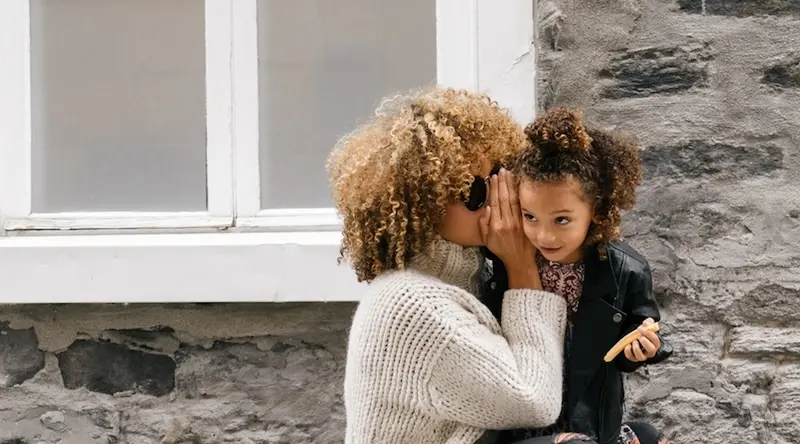settings
children
With Famly since
Open-ended vs. closed questions
It never hurts to start with the basics. In the Early Years, some key features of open-ended questions:
- Can’t be answered with yes or no.
- Don’t have a right or wrong answer.
- Encourage discussion, not short or single-word answers.
- Don’t assume too much about the activity or situation you’re questioning.
- Give control to the child, meaning the child decides which way the conversation will go.
- Interactive, and stimulates a longer conversation.

Why are open-ended questions so powerful in early childhood?
Problem solving
- There is no right or wrong answer, but instead encourages them to problem solve in a way that makes most sense to them.
- Instead of giving them the ‘right’ way to do something, open-ended questions encourage independent thinking and guide children towards finding their own truth.
- They give children the opportunity to try, fail, hypothesise, experiment and succeed on their own.
- It also demonstrates that there can be many solutions to one problem.
Encourage more language use
- Gives the child more space to verbalise and describe their thought processes, which stimulates more language use.
- With more language use, the child will naturally expand their language skills, including their pronunciation and vocabulary.
Allow educators to learn more about each unique child
- Asking open ended questions shows an interest in the child’s perspective, thoughts and opinions
- Allow the child to think beyond the obvious response. For example, you may ask: which shade of blue will you color the sky? But, maybe the child wants to paint it yellow to reflect the sunrise, or maybe yellow is her favourite colour.
- Allow the toddler to think through many possibilities before choosing what they think is the best answer or option.
- Enables the child to express a range of feelings and emotions as well as their understanding of a particular subject.
- Allow children to freely elaborate and share, what they consider to be, valuable information.
- You will learn what is most important to them, and how their brain processes different situations.
Build children’s self-confidence
- Let’s children take the lead and guide the conversation
- Help to encourage creative thinking and their imagination, rather than just simple answers
- Open-ended questions or prompts may remind the child of a previous event or situation, which can help to stimulate memory skills and abilities.
- Creates a situation where the adult must follow the lead of the child, stay engaged, actively listen and interact with the child. This helps to make the child feel that their opinion and thoughts are valued.
Sustained shared thinking
Sustained Shared Thinking is when two or more people are involved in an extended conversation, where both of you are absorbed in the joint problem-solving.
It’s been proven to be a crucial part of early childhood development, and open-ended questions are a key part of it. For more on Sustained Shared Thinking, we recommend this great article from Kathy Brodie.

Listening is key when asking open-ended questions
There are three distinct parts when asking open-ended questions: the question, listening, and responding. Seems obvious right? But, it is important that each of these phases are given the appropriate time, and do not overlap - and yes, I am especially referring to the listening part!
- A great rule of thumb is to wait 5-10 seconds for the child to think and respond.
- Don’t interrupt! It should be a back and forth conversation, but let the child completely say their answer.
- Be an active listener and show that you are interested in the child’s answers. Even though you shouldn’t interrupt, you can nod in agreement, smile, etc.
Then, when you do respond, don’t be so quick to jump to another open-ended question. Instead, try expanding on the answer the child gave, and encourage them to continue processing that topic.
The big ideas

What are good open-ended questions for nursery?
They tend to start with a ‘What’, ‘How’, ‘Where’ or a ‘Why’ (and rarely a ‘Which’ or ‘Who’, which tend to lead to multiple choice questions).
Great open-ended questions can also be considered prompts - or good conversation starters - and can start with phrases like ‘Tell me about…’ or an ‘I wonder if…’
Types of open-ended questions
Imagination and Creativity
- If you could have any ____, which one would you choose and why?
- Can you tell me a story about ____?
Problem Solving and Critical Thinking
- How do you think we ____?
- What could we build with ____?
- What else do we need to make ____?
- What do you think is going to happen when ___ ?
- Why do you think that happened?
- Do you think we could do ____ too?
- What else could we use ____ for?
Feelings and Emotions
- How do you feel when ____?
- What makes you feel happy?
- Can you tell me about a time when ____?
- What might make _____ feel better?
Other people’s feelings, emotions and experience
- How do you think ____ feels when ____?
- How do you think that made ____ feel?
Everyday Experiences and Observations
- What can you hear outside?
- Do the clouds remind you of anything?
- Can you tell me about what you’ve made?
- How are these the same? How are they different?
Personal Preferences and Opinions
- Which _____ do you like most and why?
- What's your favorite thing to do when ____?
- Would you rather ____ or ______? Why?
Curiosity and Wonder
- Why do you think _____?
- How do you think _____?
- What do you think of when ____ ?
Of course, there are countless more, but these are just some examples to provide some inspiration!

Top tips for asking open-ended questions
To finish up, we’ve got some short tips for practitioners who want to improve the way the ask open-ended questions. For this, we’re indebted to Professor Iram Siraj-Blatchford’s 2005 presentation “Quality Interactions in the Early Years’ where you can find even more ideas to support quality Sustained Shared Thinking.
- Tune in – Respect the child and how they’re feeling, including their body language, speech and actions. Don’t get so wrapped up in your own thoughts that you forget to connect with the child.
- Give your full attention – When children are engaged, try to keep eye contact and affirm with smiles and nods.
- Don’t push it – If they’re too focused to answer or engage with you, leave them be. Remember, it’s about interacting, not interfering or interrupting.
- Extend language – Repeat concepts or actions that children are doing with more complex vocabulary to promote richer language.
- Don’t assume – Keep an open mind so that you assume as little as possible. This will stop you from closing off your questions.
- Don’t ask a question that you already know the answer to – You’ll be surprised how easily young children know when you’re doing this.
- Offer your own experience – Any conversation should be a two-way street. It might be more engaging for a child to hear a little about what you think on the subject too. Just remember to keep it to your opinions and preferences.
- Meet the child where they are at – Reading the child and making sure you’re not causing them distress is the key to getting this right. But if you (or they) are struggling, these four ways to simplify questions might help:
- Make the question more concrete
- Relate them to personal experiences.
- Choose recent events or objects.
- Prioritize familiar vocabulary.
Top tips from Alphabet House
Get top tips from a setting just like yours. Hear from Alphabet House on why and how they use Famly - and why they’ve never looked back.
Read their story








